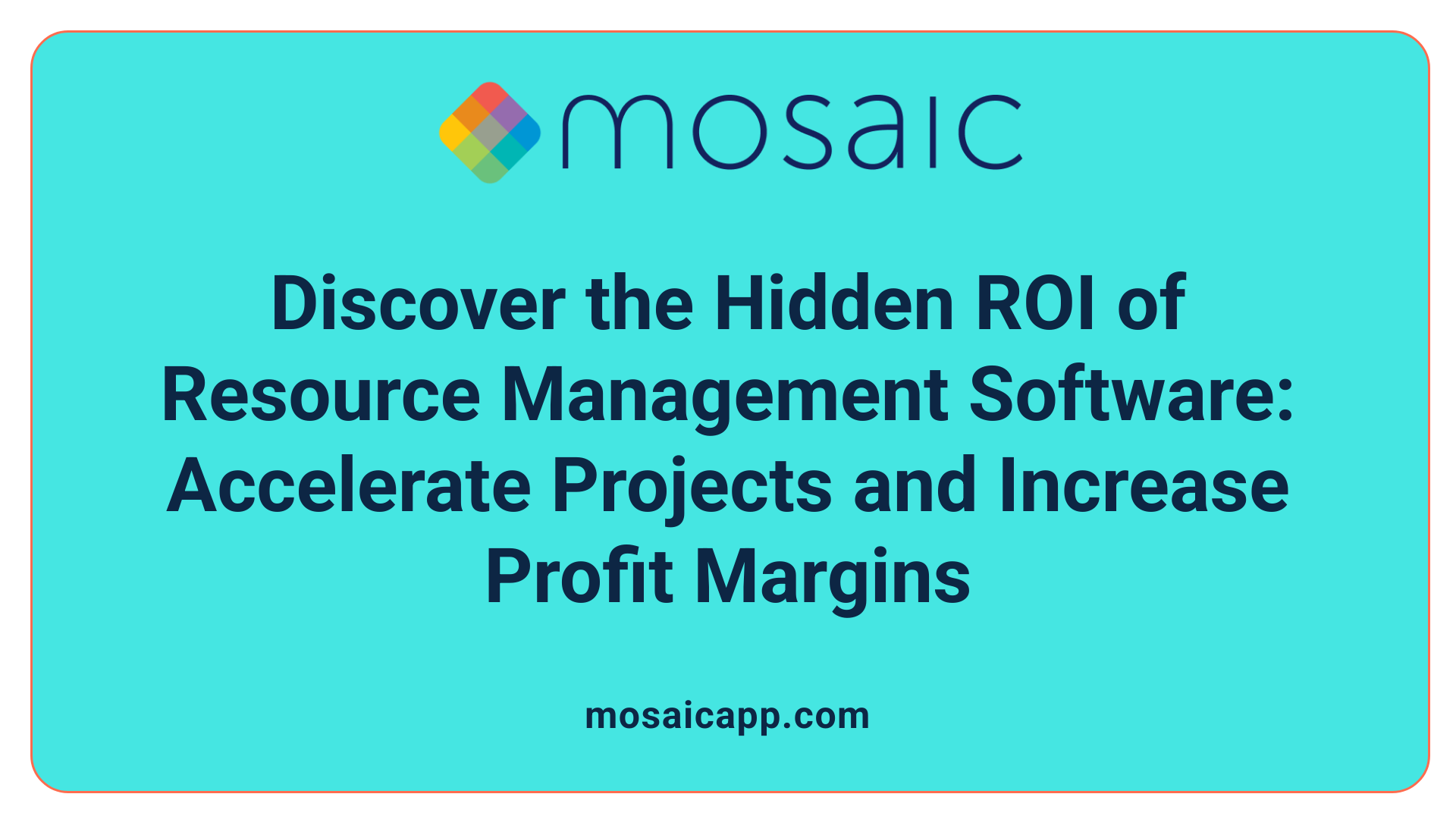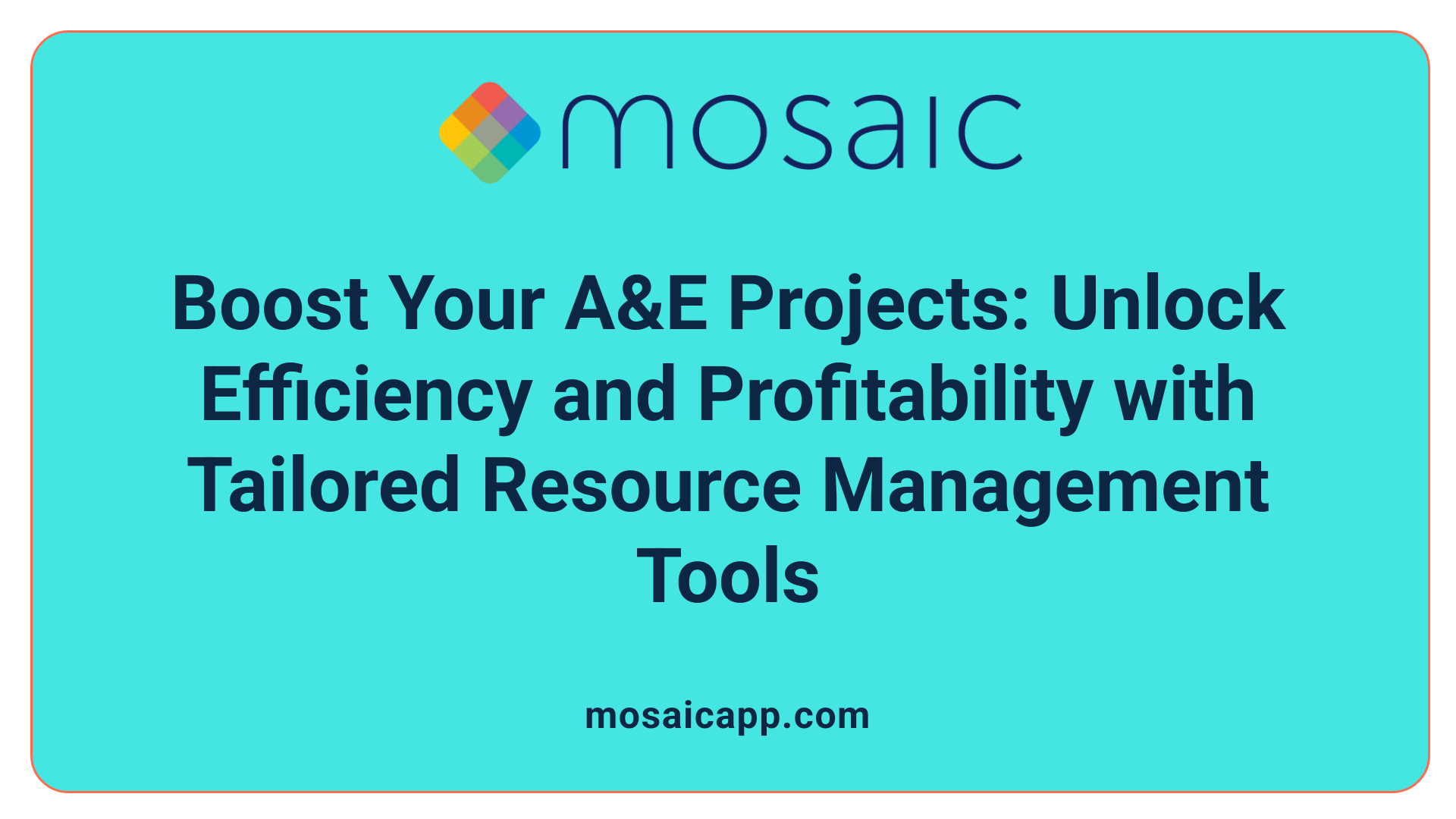Why Resource Management Software Is a Game-Changer for A&E Firms and Teams
In the competitive world of architecture, engineering, and facility management, leveraging resource management software offers more than just operational improvements—it's about uncovering hidden ROI that drives strategic growth. This article explores how industry-specific tools deliver significant benefits, from project efficiency to cost savings, and why they are essential for future-proofing your organization.
Understanding the Strategic Benefits for A&E Firms
How do resource management tools improve operational efficiency?
Resource management tools tailored for architecture and engineering (A&E) firms significantly boost operational efficiency. They help optimize resource allocation, ensuring that personnel, equipment, and materials are used effectively across multiple projects. These tools provide visibility into current workloads, highlight bottlenecks, and facilitate smarter scheduling. This proactive approach reduces project delays, avoids over- or under-utilization of staff, and streamlines workflows.
What role do these tools play in resource allocation and scheduling?
In A&E projects, complex workflows and regulatory requirements demand precise coordination. Industry-specific resource management software allows firms to forecast resource needs accurately and allocate tasks accordingly. It enables real-time adjustments to schedules, making it easier to respond to project changes. Efficient scheduling ensures that the right skills are assigned at the right times, minimizing idle time and maximizing productivity.
How do data-driven decision-making capabilities benefit firms?
Advanced resource management systems integrate financial, project, and HR data, enabling firms to make informed decisions. By analyzing trends and performance metrics, leadership can identify high-return projects, allocate resources strategically, and prioritize initiatives that enhance profitability. This data-driven approach reduces guesswork, improves project planning, and increases the likelihood of project success.
In what ways do these tools support organizational agility?
Organizational agility refers to a firm’s ability to adapt quickly to changing project scopes or market conditions. Industry-specific resource management tools facilitate scenario analysis, providing insights into potential impacts of adjustments before implementation. They support flexible resource planning, enabling quick reallocation in response to new opportunities or unforeseen challenges. This adaptability helps firms stay competitive and responsive, ensuring continued growth and profitability.
| Key Benefits | Impact on Firms | Additional Details |
|---|---|---|
| Enhanced Operational Efficiency | Faster project completion, reduced delays | Optimized resource utilization, streamlined workflows |
| Improved Resource Allocation | Better workload balance | Forecasting and real-time scheduling |
| Data-Driven Decision Making | Increased project success and profitability | Integration of financial, project, HR data |
| Organizational Agility | Swift adaptation to change | Scenario analysis, flexible planning |
Investing in industry-specific resource management tools delivers measurable advantages: higher staff utilization, cost savings, happier clients, and a stronger competitive position. Firms that leverage these technologies are better equipped to handle the complexities of A&E projects and market fluctuations, resulting in long-term success.
The Hidden ROI of Resource Management Software in A&E

What is the hidden return on investment (ROI) of resource management software for A&E teams?
Resource management software delivers more than just cost savings; its true value lies in boosting the overall performance and strategic capacity of architecture and engineering firms. These platforms automate the collection of project data and provide instant, real-time insights through dashboards, enabling teams to work more efficiently. This immediacy reduces idle time and ensures that resources are allocated optimally, leading to an increase in billable hours and higher project profitability.
One of the most significant benefits is improved project coordination. Enhanced communication and synchronization across teams allow firms to expedite invoicing and receive payments faster, thereby improving cash flow. The automation of administrative tasks reduces overhead costs and frees up valuable time for project teams, often resulting in a quick return on investment—typically within 30 to 60 days.
Furthermore, resource planning tools help visualize team capacity and support dynamic scheduling. This proactive approach to workload management prevents burnout, delays, and resource wastage, which directly impacts client satisfaction. Better planning ensures projects stay on track, meet deadlines, and improve overall client relations.
Collectively, these efficiencies and strategic advantages translate into substantial financial gains. The benefits of resource management software often go unnoticed during initial evaluations but contribute significantly to both immediate project success and the long-term sustainability of the firm. As a result, A&E organizations experience not just operational improvements but also enhanced competitive edge in a demanding industry.
Enhancing Project Efficiency and Profitability

How does resource management software contribute to project efficiency, profitability, and operational savings for A&E teams?
Resource management software plays a crucial role in boosting the effectiveness of architecture and engineering (A&E) projects. For these firms, navigating complex workflows, regulatory requirements, and collaborative processes can be challenging with generic tools. Industry-specific resource management solutions address these challenges by offering centralized scheduling, real-time project visibility, and proactive conflict resolution. These features help prevent delays and streamline workflows, reducing costly overruns.
One of the standout benefits is advanced forecasting. These tools allow A&E firms to anticipate workload demands precisely, allocate resources effectively, and make informed, data-driven decisions. This proactive approach to resource planning ensures projects stay on schedule and within budget, directly improving profitability.
Workload balancing and smart filtering further enhance operational efficiency. They enable project managers to distribute tasks and resources equitably, avoiding bottlenecks and optimizing team performance. By highlighting critical resource data, these platforms facilitate faster, better decision-making.
Moreover, integrating project management, financial tracking, and resource planning into a single, unified platform reduces administrative burdens. This integration minimizes errors, prevents financial overruns, and fosters smoother collaboration among team members.
Overall, employing specialized resource management software results in substantial operational savings, higher project success rates, and increased client satisfaction. It transforms traditional project workflows into streamlined, efficient processes tailored to the specific needs of A&E firms, ultimately contributing to enhanced profitability and competitive advantage.
Addressing Industry-Specific Challenges through Technology

Why are generic project management solutions insufficient for A&E firms?
Many architecture and engineering (A&E) firms find that standard project management software doesn't adequately support their operational needs. These generic tools often lack industry-specific features vital to A&E workflows, such as integrated drawing management, submittal tracking, and request for information (RFI) processing.
A&E projects involve complex regulatory constraints and require nuanced workflows that generic platforms cannot fully accommodate. For example, managing design revisions, coordinating between teams, and ensuring compliance with regulations demand specialized tools that are seamlessly integrated into their project environment.
Furthermore, integration is a critical challenge. Generic project management solutions tend to struggle in connecting with specialized A&E software like CAD, Building Information Modeling (BIM) platforms, and specification databases. This disconnect often results in errors, increased administrative work, and delays.
Resource management in these environments is also more complex than what most generic platforms can handle. A&E projects involve varying skill levels, licensing requirements, and regulatory standards, which demand detailed tracking and allocation capabilities. Basic resource management features may overlook these critical elements, hindering both efficiency and compliance.
Ultimately, reliance on non-industry-specific solutions can lead to increased operational costs, project delays, and compliance risks. By contrast, industry-specific project management tools are designed to streamline workflows, improve accuracy, and ensure regulatory adherence, making them essential for A&E firms aiming to stay competitive and deliver high-quality results.
Financial Impact and Cost Savings from Resource Management Solutions
What is the financial impact and potential cost savings of resource management solutions for A&E organizations?
Resource management software can significantly improve the financial performance of architecture and engineering (A&E) firms. These solutions help streamline project workflows, reduce administrative waste, and cut unnecessary expenses that often arise from operational inefficiencies.
By utilizing advanced data analytics and predictive modeling, firms can identify which teams or individuals are highly utilized and allocate resources more effectively. This not only prevents overburdening staff but also maximizes their productivity, leading to cost reductions.
For example, targeted interventions addressing social factors—such as housing or food insecurity—can cut down nonurgent emergency department visits, which cost approximately $1,716 per visit. Avoiding just a few of these visits can save between $1,500 and $3,000 per case, translating into substantial funds that can be redirected into project development or innovation.
Implementing resource management tools also enhances overall project efficiency. Faster workflows, minimized material wastage, and effective scheduling contribute to increased profit margins. Over time, these improvements build a compelling financial case for adopting advanced software platforms.
In financial terms, firms using such technology often see noticeable returns—sometimes within the first few project cycles. For instance, predictive analytics can pinpoint high-cost areas, allowing preemptive action that results in measurable savings. Overall, resource management solutions provide a broad spectrum of financial benefits, including reduced costs, higher project profit margins, and improved client satisfaction.
| Cost Reduction Strategy | Description | Typical Savings | Additional Notes |
|---|---|---|---|
| Workforce Optimization | Better resource allocation reduces overtime and underutilization | 10-20% reduction in labor costs | Using real-time data to match skills with project needs |
| Workflow Streamlining | Automating routine tasks cuts administrative overhead | Lower administrative expenses | Increases focus on core engineering work |
| Preventive Maintenance | Proactive asset management reduces emergency repairs | Up to 15-20% decrease in maintenance costs | Extends asset lifespan and minimizes downtime |
| Analytical Insights | Predictive modeling for cost-saving interventions | Cost savings of $1,500-$3,000 per avoided incident | Particularly effective in reducing costly emergency visits |
By adopting comprehensive resource management solutions, A&E firms not only cut costs but also improve operational flexibility and project delivery times, ultimately strengthening their competitive positioning.
The Future of Resource Management in A&E and Industry Impact

Technology trends
The landscape of resource management in architecture and engineering (A&E) firms is rapidly evolving with the adoption of advanced software solutions tailored to industry needs. Industry-specific project management tools now integrate seamlessly with essential design platforms like CAD and BIM, reducing errors and administrative burdens. These platforms also support complex workflows, such as RFI processing, submittal tracking, and drawing management, which are crucial for compliance and efficiency.
Moreover, automation in invoicing and real-time dashboards allow firms to monitor project performance continuously. These technological innovations enable better resource allocation, enhanced collaboration, and faster decision-making, paving the way for more agile project management practices.
Facility management (FM) and computerized maintenance management systems (CMMS) are similarly advancing with features like predictive maintenance, energy efficiency monitoring, and space utilization analysis. Integration with refrigerant management solutions ensures regulatory compliance, further reducing risks.
Long-term benefits
Transitioning from generic tools to industry-specific software results in significant long-term gains. Firms can expect a 15-20% reduction in maintenance costs within the first year and substantial savings in labor hours—up to 15 hours per team weekly. Enhanced resource visibility and real-time data support proactive decision-making, leading to improved project profitability and operational efficiency.
The ability to automate routine processes and comply effortlessly with regulatory standards minimizes legal and financial risks. Asset lifespan is extended through optimized maintenance, and energy consumption is reduced thanks to smart management features. These benefits collectively contribute to sustaining competitive advantages and increasing overall profitability.
Industry transformation
The adoption of sophisticated resource management systems is transforming the A&E industry by fostering a culture of continuous improvement and operational excellence. Firms that leverage these technologies gain a strategic edge, enabling faster project turnaround times and higher quality outputs.
A notable example shows that with effective project coordination and technology use, firms can realize ROI up to 250% within the first year. As these practices become more widespread, traditional project workflows are revolutionized, leading to a paradigm shift in how firms operate.
This transformation will influence broader industry standards, encouraging more companies to invest in scalable, customizable solutions that meet evolving client and regulatory demands. Ultimately, embracing technological advancements in resource management will be fundamental to industry resilience and growth in the coming decades.
Maximizing Value and ROI with Industry-Specific Tools
Adopting resource management software tailored to the unique needs of A&E and industry-specific firms unlocks hidden efficiencies and delivers substantial ROI. From improved project execution and operational savings to enhanced financial performance, these tools are indispensable for organizations aiming to stay competitive and innovative. As industry demands evolve, investing in the right technology becomes an essential strategic move—transforming operational challenges into opportunities for growth and excellence.
References
- A&E Project Management: Hidden Costs of Generic PM Software
- A Guide to Engineering Project Management ROI
- The Hidden ROI of Facility Management Software - Yardi Corom
- The ROI of Facilities Management Software and CMMS - Fexa
- Resource Planning Software for A&E Firms: 5 Features ...
- Mastering Resource Planning and Project Scheduling in ...
- Project Resource Management for A&E Firms: 6 Steps + Tips
- Engineering Resource Planning: Steps & Best Practices for ...


